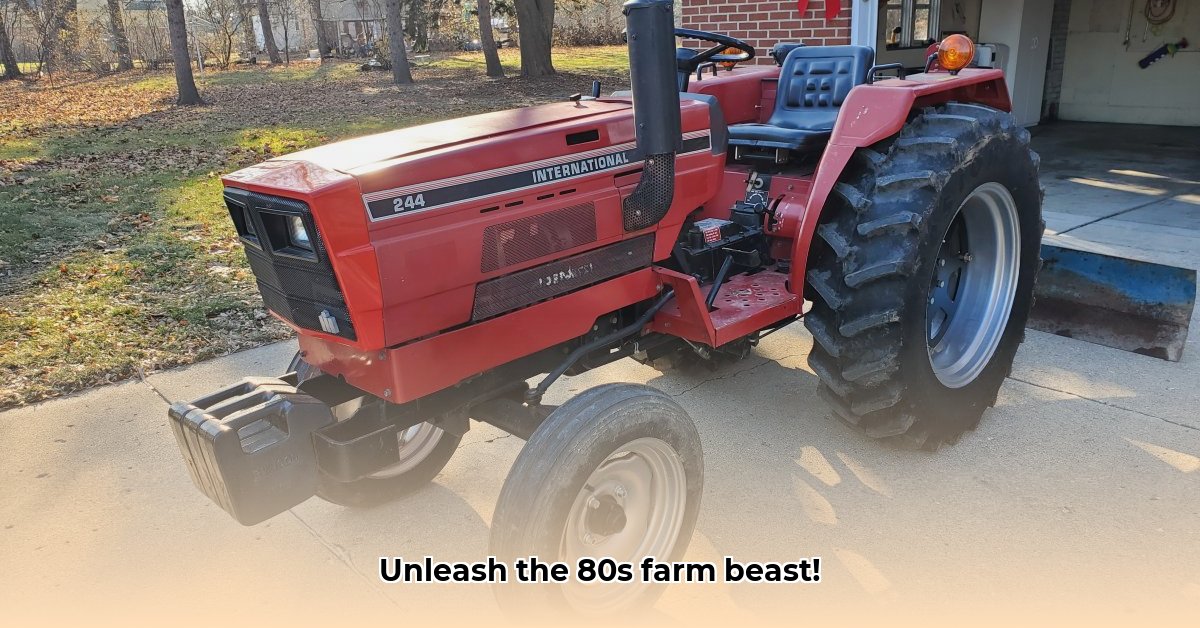
The International Harvester 244, a compact utility tractor produced from 1982 to 1984, stands as a testament to clever engineering and international collaboration. This surprisingly capable machine, a product of a partnership between International Harvester and Mitsubishi, redefined efficiency for smaller farms and specialized tasks. But what made the IH 244 so special, and what's its legacy today? Let's delve into the details. For more details on this fascinating machine, check out this dedicated site: IH 244 Info.
Under the Hood: A Closer Look at the 244's Specs
The IH 244 wasn't about brute force; its design prioritized precision and maneuverability. This compact tractor boasted a robust yet efficient powertrain, making it ideal for smaller fields and intricate farm work. Its specifications are a testament to this focus.
| Feature | Specification | Notes |
|---|---|---|
| Engine | 1.0L 3-cylinder diesel | Known for its reliability and fuel efficiency. |
| Power Output | Approximately 21 PTO hp | PTO horsepower (power taken from the tractor's power take-off shaft) varied slightly based on reported sources. |
| Transmission | 9 forward, 3 reverse gears | Offered a versatile range of speeds for diverse agricultural tasks. |
| Drive System | Available in 2WD or 4WD | Farmers could choose the drive system best suited to their needs and terrain. |
| Size | Compact | Ideal for smaller fields and navigating tight spaces between crops. |
| Weight | Relatively lightweight | Minimized soil compaction compared to larger, heavier tractors. |
This compact design provided a significant advantage. Wasn't its smaller size a key factor in its popularity amongst farmers with smaller plots of land? The dependable diesel engine, a hallmark of the era, further contributed to the tractor's appeal by delivering exceptional fuel economy – a critical factor during times of fluctuating fuel prices.
A Tractor's Place in History: The 1980s Agricultural Landscape
The 1980s saw agriculture undergoing a significant shift. Farmers increasingly sought smaller, specialized equipment capable of efficiently handling specific tasks. The IH 244 perfectly embodied this trend. Its design prioritized agility and efficiency over sheer power, reflecting the changing demands of the agricultural industry. Did this strategic focus contribute to the IH 244's market success?
On the Farm: Assessing the 244's Performance
The IH 244's performance in real-world farming scenarios was impressive. While its horsepower might seem modest by today's standards, this characteristic actually made it ideal for tasks where precision and control were paramount. Its compact size allowed for easy maneuverability in tight spaces and amongst delicate crops, making it a versatile tool for smaller-scale operations. Consider the benefits of such maneuverability; it allowed farmers to access portions of their land not readily accessible to larger tractors. How did this advantage impact overall farming efficiency?
Strengths:
- Exceptional Fuel Economy: The diesel engine substantially reduced fuel costs.
- Maneuverability: The compact size enabled easy navigation in confined areas and between closely planted crops.
- Reliable Engine: The Mitsubishi diesel engine consistently delivered dependable performance, minimizing downtime.
- Versatile Applications: The 244 proved suitable for various tasks, from tillage to mowing and light-duty jobs.
Weaknesses:
- Limited Horsepower: It wasn't suitable for large-scale plowing or heavy-duty tasks.
- Lack of Advanced Features: Compared to modern tractors, it lacked modern features like power steering and advanced electronics.
- Parts Availability: Finding replacement parts for this vintage machine can be challenging.
The 244 Today: A Collector's Item?
Today, finding a functional IH 244 is a challenge. Its limited production run and robust construction have made it somewhat of a rarity, attracting collectors and enthusiasts of classic agricultural machinery. While parts availability is a concern, its historical significance and reliability continue to make it a sought-after item among collectors. How does the challenge of parts availability affect collector interest?
Conclusion: More Than Just a Machine
The International Harvester 244 represents more than just a piece of farm equipment history; it embodies a significant period of innovation in agriculture. Its design, born from a collaboration between International Harvester and Mitsubishi, successfully captured the changing demands for smaller, more specialized farm machinery. This tractor's legacy stands as a reminder that efficiency and maneuverability are just as valuable as raw power in the world of agriculture. What is the lasting legacy of the IH 244's innovative design?